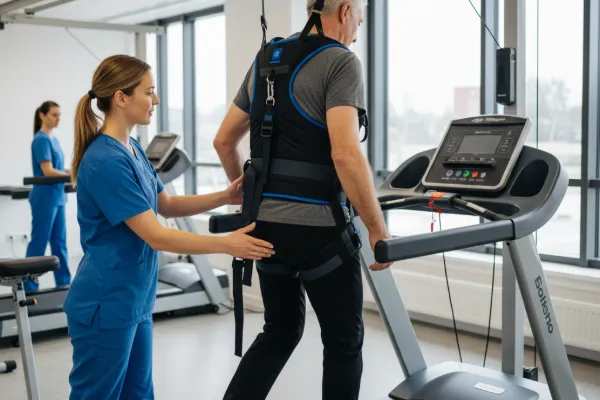
Gait Training and Balance Exercises in Physical Therapy: Regaining Strength, Stability, and Confidence
Walking — something most of us take for granted — can become difficult after an injury, surgery, or neurological condition. When mobility, balance, or coordination are affected, gait training and balance exercises play a vital role in helping patients regain their independence and confidence.
At NJ Rehab Experts, our licensed physical therapists use evidence-based techniques to help patients walk safely and efficiently again. Whether you’re recovering from a stroke, knee replacement, or simply feeling unsteady, targeted gait and balance therapy can help you move with confidence once more.
What Is Gait Training in Physical Therapy?
Gait training refers to specialized physical therapy techniques designed to improve the way you walk.
It involves retraining your body’s movement patterns, muscle coordination, and posture to enhance walking speed, balance, and endurance.
Common reasons patients need gait training:
Stroke or neurological conditions (like Parkinson’s disease)
Post-surgical recovery (hip, knee, or spine)
Sports or trauma injuries
Muscle weakness or joint stiffness
Chronic pain or arthritis
Balance disorders or frequent falls
During therapy, your physical therapist analyzes your gait using motion assessment tools and then develops a custom rehabilitation plan tailored to your needs and goals.

The Science Behind Gait Training
Your ability to walk smoothly depends on the coordination of muscles, joints, and the nervous system. When one part is disrupted — due to injury, weakness, or nerve dysfunction — your walking pattern changes, often leading to pain or imbalance.
Physical therapists use gait training to:
Re-educate muscles for proper movement patterns
Strengthen stabilizing muscles (hips, core, and legs)
Improve neuromuscular control
Correct postural and alignment issues
Reduce the risk of future injuries
With consistent therapy, patients can retrain their brains and muscles to move naturally again — a process known as neuroplasticity.
What Are Balance Exercises?
Balance exercises are designed to enhance stability and body control, especially during movement. They train your body’s proprioceptive system — your brain’s ability to sense where your body is in space.
When balance improves, so does your confidence in performing daily tasks such as walking, climbing stairs, or even standing for long periods.
Types of Gait and Balance Exercises
At NJ Rehab Experts, our therapists design individualized exercise plans that evolve as your strength and stability improve.
Here are some of the most effective techniques used in gait and balance training:
1. Strength Training
Strong muscles are key to maintaining balance.
Therapists guide patients through exercises like:
Leg raises
Mini squats
Heel-toe walking
Resistance band work
These exercises enhance core stability and leg power, making walking smoother and more controlled.
2. Proprioceptive and Coordination Exercises
These activities challenge your body’s ability to stay balanced on unstable surfaces or during movement.
Examples include:
Standing on a balance board or foam pad
Single-leg stands
Step-ups and step-downs
Walking on uneven terrain
They help train the body to react quickly and efficiently to changes in position — critical for fall prevention.
3. Treadmill or Overground Gait Training
Using treadmill-based gait therapy or overground walking with assistance, therapists help you:
Improve stride length
Correct foot placement
Develop rhythm and pacing
Increase endurance
For patients with neurological conditions, therapists may also use body-weight support systems to safely simulate natural walking movements.
4. Postural Alignment and Core Stabilization
Poor posture affects how you walk and can lead to pain or instability.
Therapists focus on exercises that strengthen your core and promote upright alignment, such as:
Seated or standing pelvic tilts
Core bracing
Controlled breathing with movement
Good posture ensures smoother, more energy-efficient gait patterns.
5. Assistive Device Training
Some patients may initially need assistive devices like canes, walkers, or crutches. Physical therapists teach correct usage to improve safety, reduce strain, and build confidence while walking independently again.
The Benefits of Gait and Balance Training
Improved Mobility: Restores your ability to move freely and confidently.
Enhanced Coordination: Reconnects the brain and muscles for smoother movement.
Better Posture: Reduces joint stress and pain during daily activities.
Fall Prevention: Improves reflexes and reaction time.
Faster Recovery: Promotes faster healing after surgery or injury.
Boosted Confidence: Helps you regain independence and quality of life.
Who Can Benefit from Gait and Balance Exercises?
Gait and balance training can help patients of all ages, especially those recovering from:
Stroke or neurological injury
Hip or knee replacement surgery
Sports injuries or fractures
Vertigo or vestibular disorders
Age-related balance loss
Chronic back or joint pain
At NJ Rehab Experts, our therapists design safe, progressive programs for seniors, athletes, and post-surgical patients alike.
What to Expect During Gait Training Sessions
Your first session typically includes:
Assessment: Your therapist evaluates your walking pattern, posture, and muscle strength.
Personalized Plan: Based on your needs, a customized therapy program is developed.
Hands-On Guidance: Therapists assist you during exercises to ensure proper form and safety.
Progress Tracking: As you improve, exercises are advanced to challenge your stability and endurance.
Each session builds on the last — gradually restoring mobility and confidence in every step.
The Role of Technology in Modern Gait Training
Today’s physical therapy clinics use innovative tools to enhance gait rehabilitation:
Motion analysis systems for detailed movement assessment
Balance platforms and sensors for real-time feedback
Body weight supported treadmills for safe walking re-education
Virtual reality therapy to simulate real-world walking challenges
At NJ Rehab Experts, we integrate advanced rehabilitation technology with personalized care to deliver the best possible outcomes.
Why Choose NJ Rehab Experts
When it comes to restoring mobility and balance, experience matters.
Our team at NJ Rehab Experts provides:
One-on-one sessions with licensed physical therapists
Evidence-based gait and balance programs
Post-injury and post-surgery rehabilitation
Fall prevention and senior balance training
Comprehensive patient education and support
Let us help you move with confidence again.
Visit us at: https://njrehabexperts.com/
Call: (212) 227-3233
Email: [email protected]
